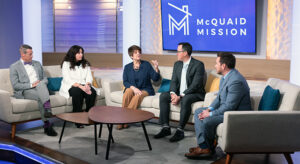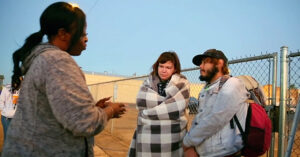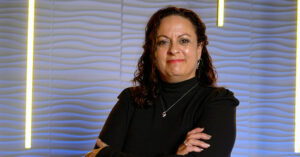In this episode of The Community Collaborative, our leaders acknowledge the time and energy companies are putting into their diversity and inclusion initiatives.
In light of the upcoming election, they reiterate the importance for leaders to empower all employees to harness the power of equity and voice not just when it comes to an organization, but in the local communities and beyond.
This week, the show’s co-hosts and producers Robin Reed, the CEO of the Black Chamber of Arizona, and Monica Villalobos, the CEO of the Arizona Hispanic Chamber of Commerce, are joined by Adam Goodman, president and CEO of Goodmans Interior Structures, as they discuss the current climate of diversity and inclusion.
Don't Miss These Highlights
Monica Villalobos kicks off the conversation by reminding leaders that, despite being front and center in recent months, diversity and inclusion are “so much more” than buzz words (1:31).
She touches upon the lessons she and The Community Collaborative have learned from incredible leaders in the community, explaining “diversity and inclusion isn’t something you give employees. It’s something that you enable them to manifest in the work environment” (1:45).
Goodman joins in to explain how the role of an effective business leader is “to make sure the rest of the leaders in the organization are attracting and retaining and developing the very best talent that’s out there” (2:45).
While this creates a space for diversity and inclusion, he explains how the problems arise when dedicated and high-quality talent is sorted out to be left on the sidelines. This unconscious separation is not in the best interest of the organization, he reiterates.
While organizations can look toward the numbers to understand their diversity, grasping the level of inclusion requires digging a little deeper. Goodman warns “the numbers can tell whatever story you want them to tell,” urging companies to go beyond looking at the number of diverse employees on payroll (3:32).
Instead, “keep looking further,” he explains, and look for common roadblocks to diversity and inclusion, often rooted in unconscious bias, such as occupational sorting (4:30), leadership bias (6:11), and wage gaps (6:49).
Goodman calls for the need to tap into the dedicated and diverse staff at our fingertips, opening pathways for development and possibilities within the company for all employees, including those in minority groups (5:40).
The issue of inequity “is not to be solved by the government,” Goodman said. Instead, he believes the power lies in business leaders to “set the tone for this change” (7:49).
Robin Reed jumps in, pointing out the power leaders have to establish the culture of a company. He explains, “if you believe that people [that look a certain way] don’t have talent, then you are taking that [belief] down through your leadership team” (9:46).
Research reveals that adopting a culture of diversity and inclusion even leads to higher chances of bringing in above-average profits (10:07).
Goodman calls for companies to “peel away” the biases that are potentially blocking the best talent out there (11:25). He suggests taking the Harvard Implicit Bias Test as an exercise for leadership teams to go through to help reveal the presence of major or minor implicit biases as a way to start the conversation.
Reed agrees, emphasizing the need for sensitivity training to better be able to understand the biases we bring to relationships with people who are different than us (13:06).
With the upcoming election, the community collaborative leaders dedicate the second half of the episode to reminding business leaders and owners of the importance of encouraging employees to get out and vote.
The best way to mobilize the minority vote is to “encourage employees to vote,” said Villalobos (20:18).
She connects back to the beginning of the conversation, reminding us that encouraging employees to vote is another way to manifest diversity and inclusion. She says, “when you are part of the new emerging minority, we’ve got to do a better job than the last one” (21:16).
Reed wraps up the conversation as he reiterates “it’s just so important that every individual that can vote, gets out and shares what’s important to them” (23:48).
“The more that we stand together, the stronger our vote will be,” Villalobos adds (24:13).
As election day quickly approaches, the leaders sign off with a reminder that we can’t let difference and hatred tear us apart. Instead, we need to stay connected to our purpose and goals.
About The Community Collaborative
Community and business leaders and individuals who want to educate themselves on diversity issues will find the series informative and educational. And anyone who wishes to get involved will have ready access to resources featured in each program.
The video series may be streamed for free through the STN app. Viewers may subscribe through STN’s website or by downloading the STN app on the App Store or Google Play.
Each program in the series will provide details on how to get involved in featured activities and initiatives. To be featured in “The Community Collaborative” series or other STN programming, contact us at 480.967.7088.
Every day, there are leaders on the front lines of the fight to improve life in our community. STN provides the platform to tell their and their communities’ stories with video series on leadership philosophies and active efforts to make positive change in our region.





